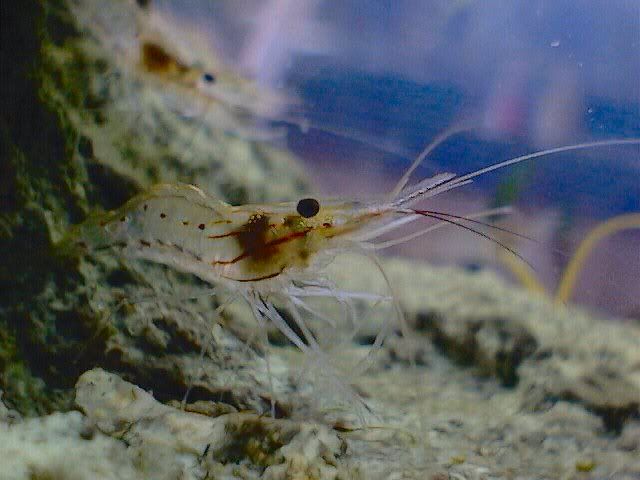Macrobrachium- feeding, water changes, & behavior
Posted: Sat Jan 22, 2005 2:22 pm
I currently possess, in a ten-gallon aquarium (to be upgraded as necessary to account for growth), a Macrobrachium sp. (rosenbergii is most likely, though, at this size, lanchesteri cannot be ruled out) around 8 centimeters in length. The tank has been cycled and established for over a year, is heated to around 76°-78° F, filtered with a Penguin bio-wheel, and is sparsely planted with an assortment of dried-bulb-grown Aponogeton, a tropical lily of similar background, and several “water ferns” (originally packed with gel in a plastic cylinder- the jury is still out on whether these are indeed true aquatics) in medium-grain gravel substrate. I regularly top off the tank with fresh water and conduct water changes every few weeks. The prawn appears to do well under these conditions, and has molted at least twice in the few months it has been in this setup.
My questions:
1. Should I be conducting water changes more frequently? Some shrimp-keeping aquarists apparently do not do so at all, but I feel doing so in my situation would be more precarious (e.g., greater bioload, in terms of both gross output and per-specimen proportion, and lower plant density).
2. I currently feed my shrimp a wide assortment of generic tropical flakes (Topfin & Aquarian), as well as shrimp pellets, Hikari “frog granules”, freeze-dried krill, and Tetrafauna Delica Bloodworms (suspended in a nutrient gel). Do you foresee any nutritional problems with this diet? Should I offer more vegetable or live food matter (I have observed it consuming dead plant fronds)? Is the risk of disease transmission low enough to be negligible if I were to provide feeder fish (~5 mm guppies)? I ask because my specimen inadvertently consumed a medaka-type "killifish".
3. What is one to make of anecdotal evidence suggesting that aqueous trace elements (namely iodine) benefit freshwater shrimp? While I know of studies suggesting that liquid iodine supplements are not bio-available to marine shrimp, does the same hold true for freshwater species?
4. Upon obtaining it (Petsmart employees felt it “just a big ghost shrimp”), I noticed an opaque/blackish blemish at the peak of its anterior ‘hump’ (I know images would better illustrate this, but I currently possess no digital camera). Through two moltings, this has neither improved in coloration nor expanded. As this is strongly reminiscent of the white-spot syndrome that claimed a previous prawn, what measures should I take against this, if any?
5. My prawn spends much of its time clinging to the interior silicone marking the intersection of two glass panes, venturing down only to forage or groom. Is this by any means unusual? Will it become more ‘benthic’ as it grows?
Any information would be appreciated.
My questions:
1. Should I be conducting water changes more frequently? Some shrimp-keeping aquarists apparently do not do so at all, but I feel doing so in my situation would be more precarious (e.g., greater bioload, in terms of both gross output and per-specimen proportion, and lower plant density).
2. I currently feed my shrimp a wide assortment of generic tropical flakes (Topfin & Aquarian), as well as shrimp pellets, Hikari “frog granules”, freeze-dried krill, and Tetrafauna Delica Bloodworms (suspended in a nutrient gel). Do you foresee any nutritional problems with this diet? Should I offer more vegetable or live food matter (I have observed it consuming dead plant fronds)? Is the risk of disease transmission low enough to be negligible if I were to provide feeder fish (~5 mm guppies)? I ask because my specimen inadvertently consumed a medaka-type "killifish".
3. What is one to make of anecdotal evidence suggesting that aqueous trace elements (namely iodine) benefit freshwater shrimp? While I know of studies suggesting that liquid iodine supplements are not bio-available to marine shrimp, does the same hold true for freshwater species?
4. Upon obtaining it (Petsmart employees felt it “just a big ghost shrimp”), I noticed an opaque/blackish blemish at the peak of its anterior ‘hump’ (I know images would better illustrate this, but I currently possess no digital camera). Through two moltings, this has neither improved in coloration nor expanded. As this is strongly reminiscent of the white-spot syndrome that claimed a previous prawn, what measures should I take against this, if any?
5. My prawn spends much of its time clinging to the interior silicone marking the intersection of two glass panes, venturing down only to forage or groom. Is this by any means unusual? Will it become more ‘benthic’ as it grows?
Any information would be appreciated.
